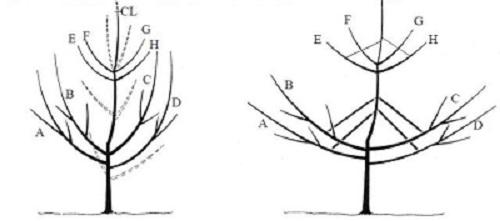How to train and prune apple and pear trees

The content of this article was published by the University of Maryland Extension Center
Pruning pear trees
- In general, the same pruning and training principles used for apple should be followed for pears.
- However, pear trees do not require as much pruning.
- Wide crotch angles are not essential, because pear trees have tougher wood that is less apt to split.
- Nevertheless, spreaders encourage flowering and fruiting in young trees.
Pruning a young apple tree
A one-year-old bare-root whip is ideal to plant. Cut it back to around 30 inches to help reestablish the plant’s previous shoot-to-root ratio.
For a branched tree:
- Leave branches that are wide-angled and arranged spirally about 6- to 9-inches apart up the leader (trunk).
- Remove poorly spaced and narrow-angled branches.
- Branches left on the tree should be reduced by up to one-half their length.
- Cut the leader about 12 to 15 inches above the top limb.

- The purpose of pruning a tree in the first 3 to 4 years after planting is to control its shape by developing a strong, well-balanced framework consisting of a central leader with scaffold branches.
- Apple trees should have a vaguely Christmas tree shape with the lowest scaffold branches having the widest spread (image above). Most apple trees will not grow into this shape without help.
- Unwanted branches should be removed when small to avoid the necessity of large pruning cuts in later years.
2nd and 3rd year pruning
- Prune your apple trees in the dormant (winter) season. March is generally the best month to prune fruit trees. However, you can prune apple trees anytime after leaf drop in the fall.
- The most vigorous upright shoot will become your central leader. Create scaffold branches by selecting 4 to 5 branches evenly spaced around the tree. None should be directly above the other.
- Also, space them vertically up and down the trunk. This is your first tier of permanent scaffold branches. Head back the central leader so that it is 6 to 10 inches above the first tier.
- Occasionally, a tree does not grow as well as it should during the first year. If this happens, prune the tree back to a whip and start over. You will delay fruiting by a year but you will have a more manageable tree.
- In the third year, branches will have sprouted just below the leader’s heading cut made the previous year. From these branches, select a second group of scaffold branches. They will be about 2 to 3 feet above the first tier. This is the tree’s second tier.

The image on the left shows a sketch of how the tree in the image above may look after the second year.
- Branches with broken lines should be removed.
- The central leader (CL) should be tipped if it grew more than 2 feet. On the right side of the figure, see the same tree after pruning and spreading of branches. All limbs in the first tier of branches (A, B, C, and D) have been spread with wooden spreaders, with a sharp-pointed nail in each end, to illustrate the beginning of the Christmas-tree shape. Limbs E and F and G and H only, in the second tier of branches, have been spread with wire having sharpened ends.
Limb Spreaders
- It is very important to force scaffold branches to grow at a 60° to 90° angle from the trunk. Use limb spreaders if necessary.
- Limb spreaders are devices that can aid in earlier fruit production, improved tree shape, strong crotch angles, and better fruit color.
- Spreaders can be either short pieces of wood with sharpened nails driven into each end, wooden spring-type clothespins, or sharpened metal rods.
- The spreaders will need to remain in place for 1 to 2 years until the branch “stiffens up.”
Pruning older apple trees
The tree’s entire production will come from the permanent scaffold branches you have selected. Since heavy pruning delays bearing, only necessary pruning cuts should be made during the next few years.
- Continue to head back all-new terminal growth by one-fourth each year.
- Remove any upright limbs (suckers at base or water sprouts on branches).
- Remove any broken or diseased limbs.
- Always maintain the central leader as the highest point on the tree. The ends of the primary and secondary scaffolds should be kept below the top of the tree.
- A major limb off a scaffold branch should not be allowed closer than 12 inches to the trunk.
- When two branches grow nearly parallel to each other in a very narrow “V” formation, remove one.
- A scaffold developing a wide “V” is also undesirable, for if both limbs are of similar size, the point of attachment is usually weak. Remove one limb.
- If two branches are growing closely parallel one above the other, one should be removed.
- Fruit weight may bend limbs downward. If a limb bends past horizontal, it weakens and will grow little. On young bearing trees, leave fruits closer to the trunk, but not heavily at the end of the limb to prevent a permanent bend from occurring in the branch.
Large cuts should be made close to the remaining limbs. Tall trees will require the removal of large limbs. Stagger severe renovation over a 2- to 3-year period. Severe pruning will lead to the growth of many vigorous water sprouts.







































